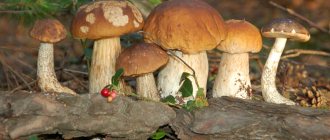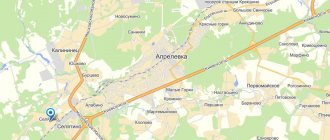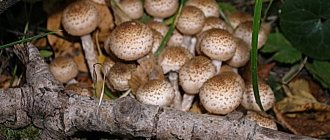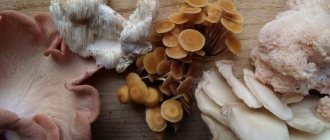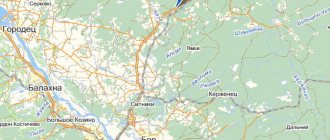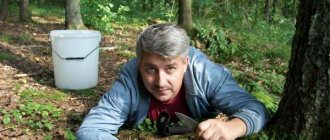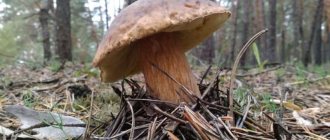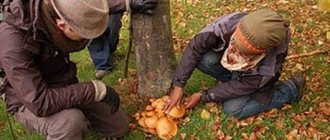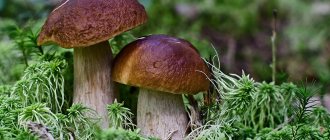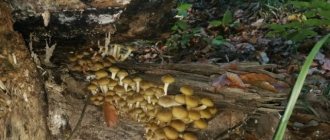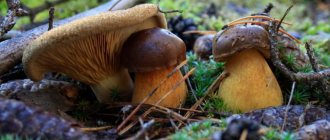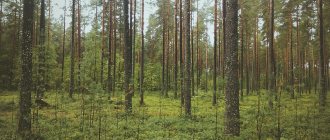When to go mushroom hunting
The mushroom season in the Moscow region can be considered open already in mid-summer. It lasts until mid-October. In general, mushrooms can be found from the beginning of April, however, the greater variety is from July. At this time, near Moscow, mushroom pickers collect many different mushrooms. Towards the end of August, the forests abound with boletuses, chanterelles, honey mushrooms and saffron milk caps. Late autumn is famous for late russula and autumn honey mushrooms.
Description and nutritional value
The white, or boletus, is considered to be the king of the forest. For lovers of “quiet hunting” it is of particular value; it is a noble representative of the mushroom kingdom.
The classic specimen of this species has a barrel-shaped leg and a fleshy, elastic brown cap. The bottom of the cap of a healthy mushroom is white to creamy yellow.
Boletus is valued for its unsurpassed taste and distinct mushroom aroma, which is why experts classified it in the 1st category of edibility. It is dried, salted, pickled, boiled and fried.
The variety of dishes with the “forest representative” can be compared only with meat: they prepare sauces, first courses, bake pies, stew them in combination with vegetables, sour cream.
Dry boletus mushrooms can be stored for up to 3 years. Regardless of any heat treatment, this product invariably remains white. Noticing this feature, people gave the mushroom the name “white.”
The miracle plant contains the protein necessary for humans, vitamins C and PP, B2. This type of mushroom is recommended for diabetics, as it helps lower blood sugar. Boletus is also valued by vegans.
Where to look for mushrooms
Experienced mushroom pickers know that mushrooms cannot be found in tall grass and dense thickets. It is simply useless to look for them there. Their habitats are considered mixed and coniferous forests. Particular attention should be paid to birch, oak, aspen, spruce and pine trees. Mushrooms are also often found on the edges of forest paths.
Experienced mushroom pickers say that you need to pick mushrooms at least 50 km from Moscow. Mushrooms tend to accumulate heavy metals. This should be taken into account when mushroom “hunting” - avoid places along roads and highways, as well as near polluting objects.
May
What mushrooms to collect: morels
Where to collect: Losino-Petrovsky district, Orlovka village. Orekhovo-Zuevo, Prokudino village. White Pillars (forest belt along the railway), Obninsk platform, where the forest was burning.
In May, the mushroom season opens in the Moscow region; the first variety that can be collected in local forests is morels. These mushrooms are very fond of old fires and slopes warmed by the sun. But there are also a lot of morels in ordinary coniferous forests; the main thing is to choose a hilly area. In principle, you can go to almost any forest in the Moscow region to pick morels, but during this period you should beware of ticks. A big advantage of morels is the absence of a large number of summer residents, who in early May try to grill kebabs and restore their gardens rather than go mushroom hunting.
Sometimes morels are found even at the end of April, but their heyday occurs in the middle and end of May. There are many recipes for preparing this inconspicuous-looking mushroom; a walk through the spring forest gives many positive emotions. You can also collect morels by car, driving further away from the city - forests have burned in almost the entire Moscow region in recent years, so it won’t be difficult to find a good fire. And many morels are found in nature reserves and even ordinary parks - these mushrooms love difficult growing conditions. Read more about morel mushrooms here. In addition, by opening the quiet hunting season, you can identify places where more noble mushrooms grow.
How to pick mushrooms
Mushroom “hunting” begins early in the morning, at 5-6 o’clock. It is also worth remembering that mushrooms almost always grow in groups, so if you find mushrooms in one place, be sure to look nearby for more. When searching, take your time; mushrooms are usually collected by calmly walking and carefully peering into the grass near the trees.
A successful find is not plucked, but cut off with a sharp short knife. Check the mushrooms immediately; if they are wormy, you cannot take them, it is better to leave them in the forest.
What to remember before going into the forest
You probably already know about this, but just in case, let us remind you: it is better to go for mushrooms early in the morning. Firstly, this way you will have fewer “competitors”. Secondly, the mushroom caps will be moist after the night and will be easier to spot in the grass.
Be sure to choose suitable clothing: it should be durable, comfortable and appropriate for the weather. It is better to give preference to natural fabrics: synthetics will be too hot. Pants should be tucked into shoes or boots: this will protect you from ticks. Don't forget to take a hat and a raincoat with you, but not one made of polyethylene - it breaks easily if it runs into branches. Shoes should have thick soles, preferably rubber.
Other necessary things you will need: mosquito repellent, matches, flashlight, compass, first aid kit, food and water, power bank, knife and container for mushrooms. A bag or bag will not work; it is better to take a wicker basket - there the mushrooms will wrinkle less and be ventilated.
Be sure to charge your phone before going into the forest!
Subject:
- Mushrooms.2021
What you need for mushroom “hunting”
An important aspect of a successful “hunt” is the equipment of a mushroom picker. What should it include:
- comfortable clothes and shoes;
- plastic bucket;
- mushroom knife;
- a stick to push apart the grass in search of mushrooms;
- first aid kit;
- drinking water;
- snack sandwiches;
- navigator;
- phone with full charge.
August
What mushrooms are collected: everything is like in July. The number of whites is growing, milk mushrooms, serushkas and greenfinches, which are good for pickling, are starting to appear.
Where to collect: in the same place as in July. But it’s still worth going to Nazaryevo, Khoroshilovo, Sobolevo, Biserevo.
There are the most mushrooms in August. This is the peak harvest in the Moscow region, so you can harvest the maximum. Naturally, it is better to look in places that are at least 80 km from the Moscow Ring Road. Far? It's a long way off, but you can find some really good redheads if you can find a big forest mane. Look at the mushroom map, look for the most extensive forest areas on satellite. In the Istra forests, on Belozerskoye, in Zakharovo they come across quite often. But in August there are even more mushroom pickers than in July, so some places near the city are completely mowed down.
You can go much further by train, but ideally, of course, go by car, and turn off the highway along a country road, at least another 10 km. Usually other mushroom pickers do not travel such distances. By the way, an application for searching mushrooms will soon be released in Moscow - it will determine the most favorable areas in terms of humidity.
In August, it is usually still quite hot in the Moscow region. If the beginning of the month is dry, it is best to hunt quietly along rivers and near wetlands. Potential mushroom spots can be indicated by moss on trees and other signs.
The most mushroom places in the Moscow region
The peculiarity of the mushroom “hunt” is that the mushroom places change every year. If last year you found a mushroom place in the forest, this does not mean at all that this year you will find them in the same place again. However, in the Moscow region there are special mushroom places where they are found year after year.
Belarusian direction
- Mushroom places with boletus, boletus and porcini mushrooms can be found at any of the stations: “Sushkinskaya”, “Petelino”, “Chastsovskaya”, “Portnovskaya”. On the south side of the tracks there is a large forest where mushroom pickers go.
- Not far from the villages of Raevo and Alyaukhovo (Skorotovo and Khlyupino stations) there are many chanterelles, if you move in the direction of the southwest. But to the north of the railway tracks, mushroom pickers collect porcini and boletus mushrooms.
Gorky direction
- Not far from the Fryazevo and Kazanskoye stations there is the village of Vsevolodovo. 3 km from it, mushroom pickers are collecting whole baskets of porcini mushrooms and chanterelles.
Kazan direction
- There are a lot of porcini mushrooms near the villages of Minino and Konyashino (Gzhel station).
- To the north of the Kuzyaevo station, chanterelles and porcini mushrooms are found. There are especially many of them on the territory of the former children’s camp “Podmoskovny”.
Kiev direction
- The south-eastern direction from the Bekasovo station is famous for mushroom places.
- There is a mushroom forest not far from the Bashkino platform.
Kursk direction
- Kolkhoznaya station is rich in mushrooms. Russula and boletus grow not far from the platform itself. There are also many mushrooms in the east, southeast and west directions from the station.
- There are a lot of honey mushrooms in the forest in the eastern direction from the Sharapova Okhota station, not reaching the village of Pleshkino.
- All kinds of mushrooms are found in the area of the Avangard station, in the forests, along the Rechma River.
Leningrad direction
- Around Pokrovka station you can find boletus, porcini mushrooms and chanterelles.
Paveletskaya direction
- 4 km to the west from the Belye Stolby and Barybino stations, mushroom pickers collect whole baskets of boletus, honey mushrooms, boletus and porcini mushrooms.
- On both sides of the railway tracks of the Velyaminovo, Privalovo and Mikhnevo stations, within a radius of 3 km, there are also many mushrooms of different stripes.
Riga direction
- In the area of the Yadroshino metro station you can collect honey mushrooms, porcini mushrooms and boletus mushrooms.
- There is also a mushroom forest not far from the Rumyantsevo station.
- North of the Lesodolgorukovo station there is a rich mushroom forest. To find mushrooms here, you need to go towards the villages of Maryino and Nudol-Sharino.
Savelovskoe direction
- If you get off at the Morozki and Turist stations and head towards Novlyanka, Paramonovo and Grigorkovo, you can find places rich in chanterelles, porcini mushrooms and boletus.
- Mushroom pickers collect a lot of chanterelles when they get off at the Taldom station, walking 4 km southwest from the platform.
Advice from experienced mushroom pickers
The white one is difficult to confuse with its poisonous variety - the satanic mushroom, which has a bright color. But the first rule of experienced mushroom pickers says: only well-known, proven specimens are placed in the basket.
Helpful Tips:
- You cannot harvest mushrooms near roads or near industrial enterprises: even the most valuable mushroom can be poisonous.
- They walk slowly through the forest, carefully looking around and studying the soil.
- As soon as the first basidiomycete is noticed, others are searched for - they always grow in families.
Under one old birch tree in a good year in the Moscow region you can collect up to three dozen porcini mushrooms
Fragile, brittle mushrooms, such as volushki and russula, should not be placed in the basket with boletus mushrooms. A full-bodied white will crush them into crumbs.
It is important to carefully examine the back side of the cap - in edible species it is, in most cases, porous, and in toadstools it is lamellar.
If they break the stem or cap, the cut of a satanic mushroom will quickly turn blue, while that of a boletus mushroom will remain unchanged.
You can smell a dubious mushroom: toadstools and their poisonous counterparts have an unpleasant odor. The aroma of the porcini mushroom is pleasant, foresty, characteristic of the species.
Upon arrival home, the forest harvest is sorted. Rotten and wormy specimens are sorted out, the rest are washed and cleaned.
The treated fruiting bodies are immersed in salted water for an hour - this will allow all undetected worms to be “pulled” to the surface.
